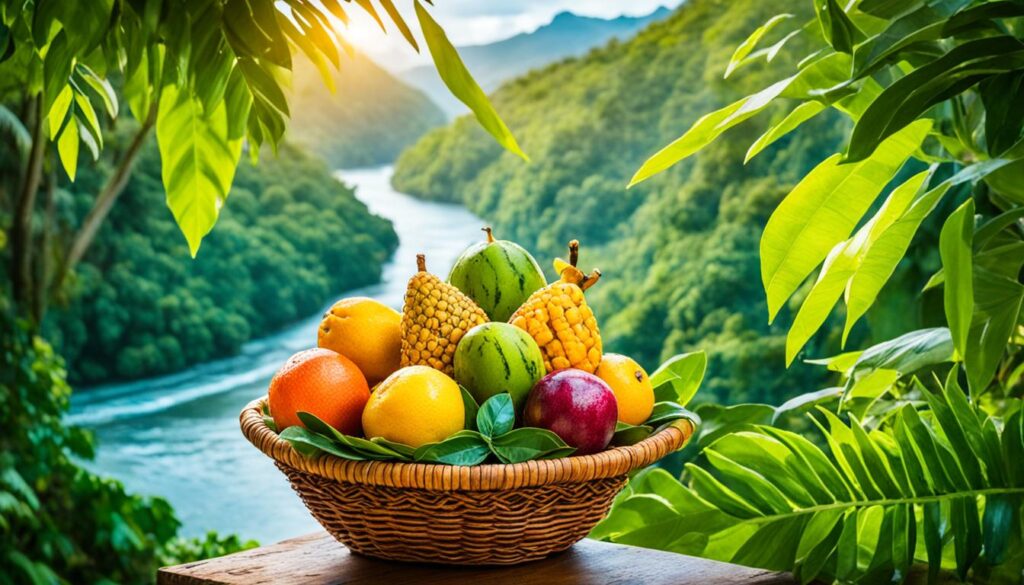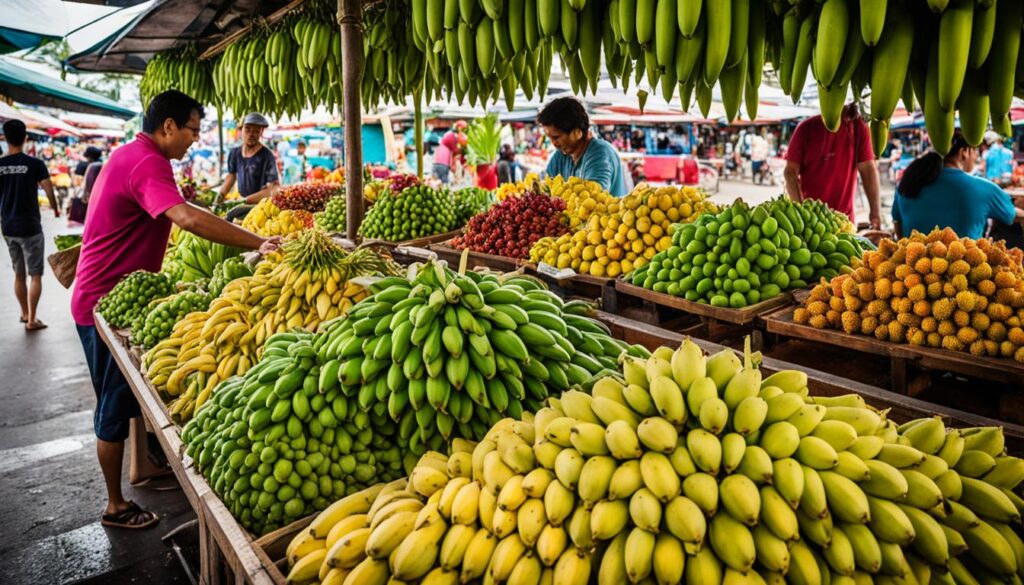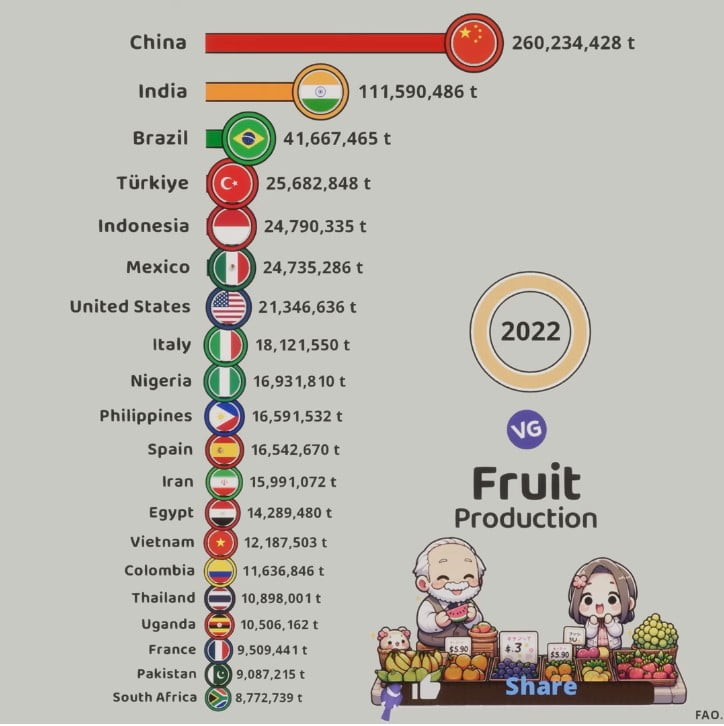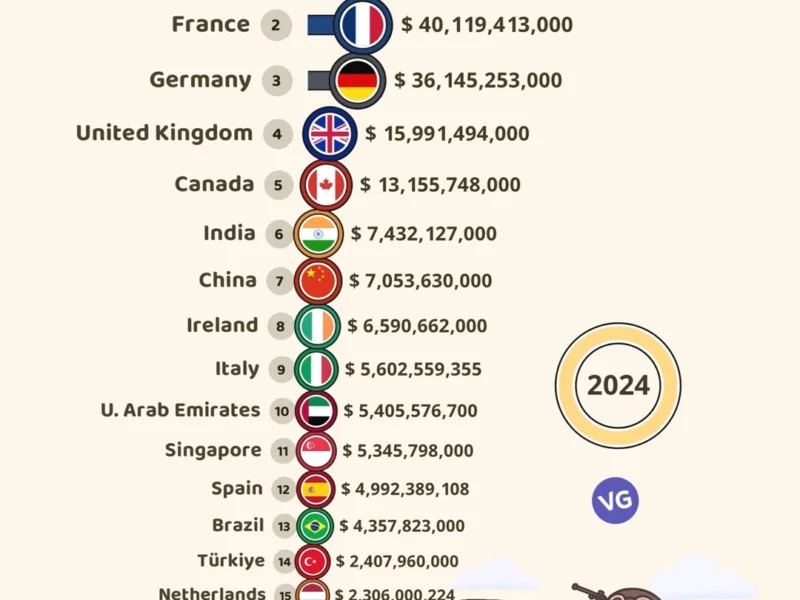The global fruit production industry is huge, producing 887,027,376 metric tonnes each year as of 20201. This is a big jump from the 200 million tonnes made in 19611. The top five countries show how big and diverse this industry is.
| Country | Flag | Fruit Production (tonnes) |
|---|---|---|
| China | 🇨🇳 | 260,234,428 |
| India | 🇮🇳 | 111,590,486 |
| Brazil | 🇧🇷 | 41,667,465 |
| Türkiye | 🇹🇷 | 25,682,848 |
| Indonesia | 🇮🇩 | 24,790,335 |
| Mexico | 🇲🇽 | 24,735,286 |
| United States | 🇺🇸 | 21,346,636 |
| Italy | 🇮🇹 | 18,121,550 |
| Nigeria | 🇳🇬 | 16,931,810 |
| Philippines | 🇵🇭 | 16,591,532 |
| Spain | 🇪🇸 | 16,542,670 |
| Iran | 🇮🇷 | 15,991,072 |
| Egypt | 🇪🇬 | 14,289,480 |
| Vietnam | 🇻🇳 | 12,187,503 |
| Colombia | 🇨🇴 | 11,636,846 |
| Thailand | 🇹🇭 | 10,898,001 |
| Uganda | 🇺🇬 | 10,506,162 |
| France | 🇫🇷 | 9,509,441 |
| Pakistan | 🇵🇰 | 9,087,215 |
| South Africa | 🇿🇦 | 8,772,739 |
China leads with a massive 253.9 million tonnes of fruit a year2. India is second, making about 107.9 million tonnes2. Brazil comes in third, producing around 39.8 million tonnes2. Turkey and Mexico complete the top five, making 25 million and 23.7 million tonnes, respectively2.
Key Takeaways
- Global fruit production reached 887 million metric tonnes in 2020, up from 200 million tonnes in 1961.
- China is the world’s largest fruit producer, generating 253.9 million tonnes annually.
- India and Brazil follow closely, producing 107.9 million and 39.8 million tonnes, respectively.
- Turkey and Mexico are also among the top five largest fruit producers globally.
- The fruit production industry has seen significant growth over the years, reflecting its importance in the global food system.
Global Fruit Production Trends
Fruit Production in 2022 (tonnes)
Source: Image data, 2022
Historical Growth and Current Statistics
Over the decades, global fruit production has grown a lot. It went from 199,837,692 tonnes in 1961 to 887,027,376 tonnes in 2020. This is more than a four-fold increase3. The growth is thanks to more land for farming, better farming tech, and more people wanting fruit3.
From 1993 to 1995, the world produced 448 million tons of fruits. By 1996, this grew to 469 million tons4. Experts predict fruit production will keep growing at a 1.6% annual rate4. China, India, Brazil, the USA, Italy, and Mexico are the top fruit producers, making up almost 30% of the world’s supply4.
In 2013, watermelons led as the most produced fruit, followed by bananas, apples, mangoes, and oranges. Fruit production worldwide went up by 3.2% from 2012 and 6% over the last four years5.
The top fruit producers in 2013 were China, India, Brazil, the United States, and Mexico5. The EU was the third-largest producer, after China and India combined5.
“Fruit production has become an increasingly important component of the global agricultural landscape.”
From 2009 to 2013, fruit and vegetable production globally increased by 6.08% and 6.11% respectively5. The U.S. is a big exporter of fresh fruits and vegetables. The USDA expects exports to grow by 5 to 7% each year435.
Powerhouse of Fruit Production: China
China is the world’s largest fruit producer, producing 242,793,824 tonnes or 27.4% of the world’s fruits in 20206. Its huge arable land, good climate, and big investments in farming make it a leader7. China grows apples, citrus fruits, grapes, mangoes, and lychees among others6.
As the top fruit producing country, China is a leader in growing many fruits6. It’s the biggest producer of pears, peaches, nectarines, plums, and sloes6. Its big farms and new farming methods keep it at the top as the largest fruit producer worldwide7.
China is also big in growing special and exotic fruits8. It leads in growing strawberries, watermelons, and papayas, adding a lot to the world’s fruit supply8.
China does more than just produce a lot of fruit. It’s also improving the quality and how it grows fruit8. By investing in new farming methods and research, China makes sure it grows high-quality fruits for both its people and the world8.
“China’s work in farming shows its dedication to having enough food and being sustainable. Being the largest fruit producer in the world is a big deal, showing its strength in farming and its ability to feed the world.”
As the world’s largest fruit producer, China has a big impact on the fruit market7. Its steady supply of many high-quality fruits makes it a key player in fruit production worldwide678.
India’s Expanding Fruit Cultivation
India is a key player in fruit production, ranking second globally with 105,971,127 tonnes in 2020. This makes up 12% of the world’s fruit production9. The country’s success comes from its varied climate, rich soil, and new farming methods.
Major Fruit Varieties and Regional Distribution
India’s fruit selection is vast and varied, with each region offering its own unique fruits. Mangoes and bananas are big in the south and east, while apples, pears, and citrus are grown in the north9. This shows the country’s strong horticultural tradition and farmers’ flexibility.
Exotic fruits are now a big part of India’s fruit scene. Dragon fruit farming has grown from 3,000 hectares in 2023 to a planned 50,000 hectares in five years10. Kiwi farming has also jumped, from almost nothing in 2010 to 5,000 hectares in 2023, producing 16,000 MT10.
The market for exotic fruits in India is worth ₹3,000 crores, mainly in big cities and tourist spots10. This has led to a rise in fruit exports, like kiwi, which went from 0.35 tonnes to 528 tonnes in 202310. The government’s support and the growing wealth of Indians are behind these trends.
India’s fruit and vegetable production is also noteworthy. In 2021-22, it produced 204.61 million metric tonnes of vegetables and 107.10 million metric tonnes of fruits11. These numbers highlight India’s leading role in horticulture, with lots of room for growth and innovation.
As India grows as a fruit powerhouse, farmers, policymakers, and agribusinesses must work together. They need to focus on sustainable farming, diversify crops, and improve rural livelihoods9. With its resources, innovation, and food security goals, India is set to lead in fruit cultivation91011.
Brazil’s Exotic Fruit Basket
Brazil is a giant in fruit production, ranking third in the world. It produces over 41 million tons of fruit every year. This is from the hard work of farmers on 2.6 million hectares of land12. The country is famous for its wide variety of fruits, from the healthy açai to the tangy cashew apple and the bright purple berry. It also grows common fruits like guava, papaya, and banana13.
The tropical climate and rich soils in Brazil are perfect for growing many fruits12. The Southeast region leads in fruit production, making up 51% of the total12. The Northeast and South add 24% and 12%, respectively12. The São Francisco Valley in the Northeast is a key area, producing 62% of Brazil’s table grapes and 61% of mangoes12.
Most of Brazil’s fruit farms are small, family-run businesses12. These farms, along with the country’s varied climate, create a wide range of fruits. This variety delights people in Brazil and around the world13.

Brazil exports over 40 types of fruit, making $1.07 billion in 202114. Mangoes, melons, grapes, limes, apples, watermelons, and papayas make up most of these exports. The European Union, United Kingdom, and United States buy the most14. With its natural benefits and growing demand for exotic fruits, Brazil is set to become an even bigger player in the market121314.
biggest fruit producers in the world
The global fruit industry is vibrant and diverse. Countries like Chile are major players in fruit production and export15. Chile sends over 2.6 million tons of fruit to more than 100 countries each year15. They offer fruits like cherries, blueberries, grapes, and apples all year round15.
Some countries lead the way in fruit production15. China, India, Brazil, and others make up over 80% of the world’s fruit production15. This shows their big impact on the fruit market worldwide.
| Rank | Country | Top Fruit Varieties |
|---|---|---|
| 1 | China | Apples, Citrus, Grapes, Bananas |
| 2 | India | Mangoes, Bananas, Citrus, Grapes |
| 3 | Brazil | Oranges, Bananas, Pineapples, Mangoes |
| 4 | Turkey | Grapes, Citrus, Apples, Cherries |
| 5 | Mexico | Avocados, Berries, Citrus, Mangoes |
These countries have strong agricultural sectors. They use good climates, advanced farming, and trade policies to lead in fruit production16. For example, Stemilt Growers and Evans Fruit Company in the U.S. grow a lot of apples and pears16. Bronco Wine Company grows grapes for wine in California16.
Big companies like Dole Food Company also help the fruit industry17. Dole has over 300,000 acres of crops in many countries17. Chiquita Brands International is a big banana producer, and groups like PMA support the fruit industry17.
The demand for fresh, nutritious fruits is growing. The top fruit producers are ready to meet this demand and keep leading the fruit market151617.
Turkey’s Diverse Fruit Offerings
Turkey is a big player in the world of fruit production, ranking fourth with over 24 million tonnes in 202018. Its diverse climate and fertile soil let it grow many types of fruits. Each fruit has its own special taste and uses in cooking.
Sustainable Farming Practices in Turkey
Turkey is leading the way in sustainable farming to keep its farms going for the future19. It’s known for organic farming and controlling pests in a smart way. These methods make farming more cost-effective and better for the planet.
Turkey’s fruit selection is amazing18. It has over 1,200 grape types, with each area focusing on a special grape18. Plus, there are more than 500 apple types, making Turkey a big player in apple production and export18.
Malatya is famous as the top apricot producer in the world18. Apricots from Turkey are known for their unique taste, color, and feel18. Apricot jam, or “kayısı reçeli,” is a must-have at Turkish breakfasts18. Pomegranates are also a big deal in Turkish food, used in many dishes and celebrated in festivals18.
Turkey does more than just grow fruit19. It’s among the top ten in agriculture, with a lot of land for farming19. Farming employs about 15% of the workforce and adds over 5% to the GDP, making up 10% of exports19.
Turkish food shows how versatile fruits can be, using them in traditional dishes and desserts18. From Yaprak Sarma with sour cherry to Mutancana with dried apricots, fruits are key in Turkish cuisine18. Desserts like quince and walnut-stuffed dried figs add a special touch to Turkish sweets18.
Turkey’s focus on sustainable farming and its wide variety of fruits make it an interesting example in global fruit production19. As Turkey keeps innovating, its impact on the world of fruit is set to grow even more191820.
Mexico’s Vibrant Fruit Culture
Mexico is a top fruit producer worldwide, ranking fifth in 2020 with 23,837,562 tonnes21. Its culture is deeply tied to fruit, with avocados, guavas, papayas, mangoes, and pineapples being key in its cuisine22. The country’s varied climates and ecosystems support a wide range of fruits, enriching its fruit culture.
Mexico leads in avocado production, with the U.S. alone consuming 2.5 billion pounds yearly21. Its pineapples are sweeter and juicier than those in the U.S. and Europe22. Mangoes are also popular, with each Mexican eating about 28lbs annually22.
Guavas, native to Mexico and Central America, are another major fruit22. The country also grows unique fruits like guanabana, cherimoya, mamey sapote, and chicozapote22. Quince, or membrillo, is used to make jams and liqueurs because of its high pectin content22.
Its fruit culture goes beyond just production. Nopales and Huayas are staples in Mexican diets23. Soursop, a Vitamin C-rich fruit, is used in drinks and sweets23. Pithaya, or Dragon Fruit, is like the Mexican kiwi, sweet and smooth23.
Mexico’s wide variety of fruits, rooted in its heritage, makes it a leader in fruit production and consumption.
Indonesia: Tropical Fruit Paradise
Indonesia is the sixth-largest fruit producer in the world, a true tropical fruit paradise24. Its diverse landscapes and tropical climate make it perfect for growing many tasty fruits. From the famous durian to the unique snakeskin fruit, Indonesia celebrates its natural gifts.
Small-scale farmers in Indonesia are key to this fruit success. They use traditional methods passed down through generations24. These farmers help keep Indonesia’s fruit diversity alive, adding to the unique tastes and cultural value of its fruits.
Exploring Indonesia’s Tropical Fruit Bounty
Indonesia’s fruits are a feast for the senses24. The mangosteen, or manggis, is sweet and juicy with a purple skin. The snakeskin fruit, or salak, is sweet and tangy, known for its scaly look.
The durian, called the “King of Fruits,” is loved and debated in Indonesia24. It’s enjoyed fresh and in desserts like durian pancakes and ice cream. Rambutan is another favorite, with its bright colors and sweet taste, often eaten fresh or in desserts.
Soursop, or sirsak, is sweet and sour with a creamy feel24. The Java plum, or juwet, is popular in Bali and Indonesia for its unique flavor and use in local dishes.
Indonesia also has Kintamani oranges, sweet with a hint of sourness24. And there’s the rare buni fruit, found in Bali, Java, and Sumatra24.

Indonesia’s fruit diversity shows its natural wealth and the hard work of small-scale farmers2425. They keep this tropical fruit paradise alive.
“Indonesia’s fruit industry is a living, breathing tapestry of tradition, innovation, and a deep reverence for the land. It is a true celebration of the region’s natural bounty.”
| Fruit | Season |
|---|---|
| Salak (Snakeskin Fruit) | 26 |
| Nyuh Gading | 26 |
| Noni | 26 |
| Buah Kedondong | 26 |
| Jeruk Bali (Pomelo) | 26 |
| Jeruk Siam | 26 |
| Durian | 26 |
| Sirsak (Soursop) | 26 |
| Ceroring | 26 |
Small-scale farmers in Indonesia are crucial for the country’s fruit diversity25. They use traditional methods and love for the land. Their work keeps these tropical fruits available, preserving Indonesia’s cultural and natural heritage.
United States: Leading Non-Citrus Producer
The United States is a big player in the world of fruit production, ranking seventh globally. In 2020, it produced a huge 23,747,765 tonnes of fruit27. The country is a big producer of non-citrus fruits like apples, strawberries, lemons, and oranges. These fruits grow well in many parts of the US because of the good climate.
California is the top fruit producer in the US, making almost 75% of the country’s fruit and nuts over the last ten years28. Its farms add over $100 billion to the economy each year and send more than $20 billion worth of food and products abroad, making up 16% of US farm exports28. California’s farms, including those for almonds, walnuts, and grapes, bring in $14 billion a year, which is 28% of the state’s farm income28.
The US citrus industry has had tough times, but it’s still a big player. Oranges lead citrus production, followed by lemons, tangerines, and grapefruit29. But citrus production has dropped by 65.3% since 199829. Diseases, less land, and bad weather have hit citrus farms hard, especially in Florida27.
| Fruit | Production (Million Tons) | Share of US Citrus Production | Fresh Market Share |
|---|---|---|---|
| Oranges | – | 59% | 17% |
| Lemons | – | 19% | 76% |
| Tangerines | – | 15% | 73% |
| Grapefruit | – | 7% | 55% |
Even with challenges, the US citrus industry is still worth about $3.33 billion29. The US is the world’s biggest orange juice drinker and imports most of it from countries like Chile, South Africa, and Mexico29. It also sends some orange juice to places like Canada, South Korea, the European Union, and the Dominican Republic29.
In conclusion, the United States leads in non-citrus fruit production, with California at the forefront. The US citrus industry has faced problems but is still important in the global fruit market. It supplies fruit to both the US market and exports to other countries272829.
Spain’s Fruit Export Dominance
Spain’s fruit industry is a big part of its economy and a key player in the world fruit trade. It’s the eighth-largest fruit producer, making 19,471,070 tonnes in 202030. Spain is a big exporter of fresh fruits like avocados, oranges, watermelons, and small citrus fruits31. It makes up about 10% of the world’s fresh fruit and vegetable trade31. Spain sends over 12 million tonnes of fresh fruit and vegetables worth over 12 billion euros every year31.
Spain leads Europe in producing many fruits, such as oranges, small citrus fruits, avocados, watermelons, peaches, peppers, and lemons30. Its good location, climate, and farming methods make it a big supplier of fresh produce to Europe and beyond30. In 2016, 93% of Spain’s fresh fruit and vegetables went to EU countries, with Germany, France, and the UK being the top buyers31.
Spain’s fruit exports have stayed steady lately31. But, it’s adapting to new market trends. It’s buying more fresh fruit and vegetables from places like Peru and Morocco to meet changing consumer needs30. With its strong position, location, and diverse production, Spain is a key player in the global fruit trade. It meets the growing demand for healthy and sustainable food32.
FAQ
What is the total world fruit production?
In 2020, the world produced 887 million tonnes of fruit. This is a big jump from 200 million tonnes in 1961.
Which are the top 5 fruit producing countries in the world?
The top 5 countries for fruit production in 2020 were: China, India, Brazil, Turkey, and Mexico. China led with 242 million tonnes.
How has global fruit production changed over time?
Fruit production has grown a lot over the years. It went from 199 million tonnes in 1961 to 887 million tonnes in 2020. This growth is thanks to more land for farming, better technology, and more people wanting fruit.
What is China’s role in global fruit production?
China is the biggest fruit producer, making 27.4% of the world’s fruit in 2020. It has a lot of land, a good climate, and invests in farming technology. China grows many fruits like apples, oranges, grapes, mangoes, and lychees.
How does India contribute to global fruit production?
India is the second-biggest fruit producer, making 12% of the world’s fruit in 2020. It grows many fruits like mangoes, bananas, oranges, and grapes. Different parts of India grow different fruits, making it a fruit-rich country.
What is Brazil’s role in the global fruit market?
Brazil is the third-biggest fruit producer, making 39 million tonnes in 2020. It’s known for exotic fruits like acai and passion fruit, as well as common ones like bananas and papayas. Its climate and soil are perfect for growing many fruits.
Who are the other major fruit producing countries in the world?
The top 10 fruit producers in 2020 were: China, India, Brazil, Turkey, Mexico, Indonesia, the US, Spain, Italy, and the Philippines. Together, they make over 80% of the world’s fruit, showing their big impact on the fruit market.
What is Turkey’s contribution to global fruit production?
Turkey is the fourth-biggest fruit producer, making 24 million tonnes in 2020. It grows many fruits like cherries and apricots in its Mediterranean climate. Turkey also uses sustainable farming to make fruit production better for the environment and more cost-effective.
How important is fruit production in Mexico?
Mexico is the fifth-biggest fruit producer, making 23 million tonnes in 2020. Fruit is a big part of Mexican culture, with foods like avocados and mangoes being very important. Mexico’s different climates let it grow a wide variety of fruits.
What is Indonesia’s role in global fruit production?
Indonesia is the sixth-biggest fruit producer, making 23 million tonnes in 2020. Its tropical climate and fertile soil are perfect for growing fruits like durian and rambutan. Small farmers in Indonesia use traditional methods to grow a wide variety of fruits.
How does the United States contribute to global fruit production?
The US is the seventh-biggest fruit producer, making 23 million tonnes in 2020. While it produces a lot of fruit, it also imports some. The US grows fruits like apples and strawberries in its favorable climate.
What is Spain’s role in the global fruit trade?
Spain is the eighth-biggest fruit producer, making 19 million tonnes in 2020. It’s a big fruit exporter, sending avocados and oranges to markets around the world. Spain’s fruit industry is important for its economy and its role in the global fruit trade.
Source Links
- List of countries by fruit production – https://en.wikipedia.org/wiki/List_of_countries_by_fruit_production
- List of Top 10 Fruit Producing Countries in the World – GeeksforGeeks – https://www.geeksforgeeks.org/fruit-producing-countries-in-the-world/
- Choices Magazine Online – https://www.choicesmagazine.org/choices-magazine/theme-articles/trends-and-challenges-in-fruit-and-tree-nut-sectors/challenges-for-the-us-fruit-industry-trends-in-production-consolidation-and-competition
- AN OVERVIEW ON SOCIO-ECONOMICAL AND TECHNICAL ISSUES – https://www.fao.org/4/y4358e/y4358e04.htm
- PDF – https://www.freshfel.org/docs/FAQ/Fact_Sheet_-_world_production_2009_-_2013.pdf
- List of largest producing countries of agricultural commodities – https://en.wikipedia.org/wiki/List_of_largest_producing_countries_of_agricultural_commodities
- Top 10 Largest Producer of Fruits & Vegetables in The World – https://worldunfolds.com/largest-producer-of-fruits-and-vegetables-in-the-world/
- Top Agricultural Producing Countries in the World – https://catking.in/top-agricultural-producing-countries-in-the-world
- India at a glance | FAO in India | Food and Agriculture Organization of the United Nations – https://www.fao.org/india/fao-in-india/india-at-a-glance/en/
- Fruit for thought: Farmers turn to cultivation of exotic varieties – https://m.economictimes.com/news/economy/agriculture/fruit-for-thought-farmers-turn-to-cultivation-of-exotic-varieties/articleshow/108308729.cms
- India’s Fruits and Vegetables Industry | IBEF – https://www.ibef.org/blogs/india-s-fruits-and-vegetables-industry
- Brazilian fruit farming: diversity and sustainability to feed Brazil and the world | Brazilian Farmers – https://brazilianfarmers.com/news/brazilian-fruit-farming-diversity-and-sustainability-to-feed-brazil-and-the-world/
- Variety of fruit found in Brazil – Places to Visit Brazil – https://placestovisitbrazil.com/variety-of-fruit-found-in-brazil/
- Brazil exported record volumes of fruit in 2021 – https://www.freshplaza.com/north-america/article/9479462/brazil-exported-record-volumes-of-fruit-in-2021/
- Fruits From Chile | Fruits From Chile – https://fruitsfromchile.com/
- Top 100 Fruit Growers – https://www.growingproduce.com/fruits/top-100-fruit-growers/
- Top 10 Companies of the Fruit and Vegetable Industry – https://vinut.com.vn/2023/blogs/top-10-companies-of-the-fruit-and-vegetable-industry/
- From Orchard to Table: Most Popular Turkish Fruits – Chef’s Pencil – https://www.chefspencil.com/turkish-fruits/
- Agriculture in Turkey – https://en.wikipedia.org/wiki/Agriculture_in_Turkey
- Eating with the seasons: All about Turkey’s fruit and veggie harvest in the heart of spring – https://www.dailysabah.com/turkey/expat-corner/eating-with-the-seasons-all-about-turkeys-fruit-and-veggie-harvest-in-the-heart-of-spring
- About Us | Avocados From Mexico – https://avocadosfrommexico.com/about/
- 32 Mexican Fruit You Need To Try (Exotic And Ordinary) | Mexican Made Meatless™ – https://mexicanmademeatless.com/mexican-exotic-and-tropical-fruits/
- The five fruits you must try on your mexican vacation – https://www.barcelo.com/pinandtravel/en/mexican-fruits/
- 11 Tropical Fruits to Try in Bali & Indonesia – Chef’s Pencil – https://www.chefspencil.com/tropical-fruits-bali-indonesia/
- INDONESIA – PARADISE OF TROPICAL FRUITS – ITPC – https://itpcchennai.com/blog/indonesia-paradise-of-tropical-fruits/
- 27 Exotic Bali Fruits that Will Make You Want to Jump on a Plane – https://www.baconismagic.ca/indonesia/bali-fruits/
- U.S. Citrus Production in 2022–23: Winners and Losers – – https://citrusindustry.net/2023/11/29/u-s-citrus-production-2022-23-winners-losers/
- California Farmland: The Largest Food Producer In The US – https://farmtogether.com/learn/blog/california-farmland-the-largest-food-producer-in-the-us
- Choices Magazine Online – https://www.choicesmagazine.org/choices-magazine/theme-articles/trends-and-challenges-in-fruit-and-tree-nut-sectors/trends-and-issues-facing-the-us-citrus-industry
- The Spanish market potential for fresh fruit and vegetables – https://www.cbi.eu/market-information/fresh-fruit-vegetables/spain/market-potential
- Spain is the number one exporter of fresh fruit and vegetables globally – https://www.freshplaza.com/north-america/article/2185412/spain-is-the-number-one-exporter-of-fresh-fruit-and-vegetables-globally/
- Spanish Tropical Fruits Market – Size, Import & Export Forecast – https://www.mordorintelligence.com/industry-reports/spain-tropical-fruits-market



